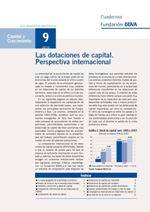China and India stand out, along with South Korea and Turkey, for their high rates of capital accumulation
The BBVA Foundation and the Ivie have disseminated the note Capital endowments. International perspective in the Capital and Growth series, describing the generalized capital accumulation that has taken place in the world economy since 1985. The information provided is of great interest due to its relationship with the capacity of each country to develop activities that are more or less productive. It also describes how the recent capitalization processes have enabled some countries to make important advances in productivity and per capita income.
Note no.9-2010: Capital endowments. International perspective
 In the last quarter century, the world economy has experienced a generalized process of capital accumulation. The path has not been the same for all the economies. The data in this issue shows that, from a selection of major economies in Europe, America and Asia, the emerging economies of Asia stand out over the rest.
In the last quarter century, the world economy has experienced a generalized process of capital accumulation. The path has not been the same for all the economies. The data in this issue shows that, from a selection of major economies in Europe, America and Asia, the emerging economies of Asia stand out over the rest.
However, in the analysis accompanying the data, Francisco Pérez (Universitat de València and Ivie) explains that "with globalization all economies have easier access to capital but do not converge in their ability to productively make the most of their abundant endowments". He also states that countries with a more mature development trajectory have more advantage in this regard.
This publication details the differences in capital accumulation among countries, information of great interest because both the available capital endowments and their composition represent an important part of a country's capacity to develop activities that are more or less productive. It illustrates what the capital endowments are per person, worker and unit.
According to the data presented in this note, Spain had in 2008 the highest capital endowments per worker from the economies studied, 24% more than Germany. Along with this, Spain stands as one of the countries that use capital injections less efficiently.
Are the differences in capital accumulation between economies lower since 1985? Yes, as indicated by the data in this issue. In addition, it also shows that the greatest difference between the economies analyzed is currently in their capital endowments per capita.
Also, this note shows the impact of the crisis on investment flows, which has been very different across economies.
This number concludes a series of notes that analyze the sources of economic growth in major economies.
Other related notes:
5-2010 Sources of world economic growth since 1995
6-2010 Sources of economic growth in Latin America
7-2010 Sources of economic growth and productivity in Spain
8-2010 Sources of economic growth in Asia
For further information on the notes in the Capital and Growth series.
The BBVA Foundation and the Ivie have disseminated the note Capital endowments. International perspective in the Capital and Growth series, describing the generalized capital accumulation that has taken place in the world economy since 1985. The information provided is of great interest due to its relationship with the capacity of each country to develop activities that are more or less productive. It also describes how the recent capitalization processes have enabled some countries to make important advances in productivity and per capita income.
Note no.9-2010: Capital endowments. International perspective
 In the last quarter century, the world economy has experienced a generalized process of capital accumulation. The path has not been the same for all the economies. The data in this issue shows that, from a selection of major economies in Europe, America and Asia, the emerging economies of Asia stand out over the rest.
In the last quarter century, the world economy has experienced a generalized process of capital accumulation. The path has not been the same for all the economies. The data in this issue shows that, from a selection of major economies in Europe, America and Asia, the emerging economies of Asia stand out over the rest.However, in the analysis accompanying the data, Francisco Pérez (Universitat de València and Ivie) explains that "with globalization all economies have easier access to capital but do not converge in their ability to productively make the most of their abundant endowments". He also states that countries with a more mature development trajectory have more advantage in this regard.
This publication details the differences in capital accumulation among countries, information of great interest because both the available capital endowments and their composition represent an important part of a country's capacity to develop activities that are more or less productive. It illustrates what the capital endowments are per person, worker and unit.
According to the data presented in this note, Spain had in 2008 the highest capital endowments per worker from the economies studied, 24% more than Germany. Along with this, Spain stands as one of the countries that use capital injections less efficiently.
Are the differences in capital accumulation between economies lower since 1985? Yes, as indicated by the data in this issue. In addition, it also shows that the greatest difference between the economies analyzed is currently in their capital endowments per capita.
Also, this note shows the impact of the crisis on investment flows, which has been very different across economies.
This number concludes a series of notes that analyze the sources of economic growth in major economies.
Other related notes:
5-2010 Sources of world economic growth since 1995
6-2010 Sources of economic growth in Latin America
7-2010 Sources of economic growth and productivity in Spain
8-2010 Sources of economic growth in Asia
For further information on the notes in the Capital and Growth series.






